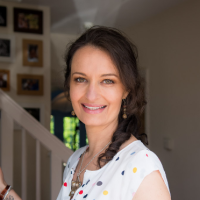View this post on Instagram
Around this time of year, I used to start becoming really conscious of “bikini season.”
Whether I had a summer holiday booked or just the fleeting thought of getting out the summery tops, either way, I’d cringe.
I knew that it was time to jump on one of my month-long detoxes so that I could feel happier about exposing my skin.
Each day during my fad diet, I would hop on the scales to see how much weight I’d lost, and I’d suck in my tummy feeling annoyed at my mirror reflection. Why wouldn’t my body comply? Why was it impossible to get those defined abs like I wanted?
Every year, the same: anger, irritation, and self-loathing that my body wasn’t like the toned Instagram influencers who promised me a body like theirs if only I followed them.
Here’s the thing. Even at my absolute slimmest, I never felt comfortable throwing off the sarong and running barefoot into the ocean. Nope. I’d wear that wrap until the last minute and slip (hopefully unnoticed) into the sea.
Why did I feel this way?
Why did I never feel good enough, slim enough, toned enough to run carefree and show off my body?
It’s taken me a long while to realise this, but it’s not our bodies that are the problem but rather society’s expectations of what our bodies should look like that is the problem.
To highlight this, please do a thought experiment with me.
Think back some years ago to a time when (objectively speaking) you looked fabulous.
Now answer this question: How did you feel about your body back then?
Here’s my answer to this question: A few years ago, I was (objectively speaking) pretty slim. But you know what? Back then, I was harping back to my honeymoon days when I was (possibly) slimmer.
And then if I think back to how I felt about my body on my honeymoon…well, it still wasn’t enough. I still didn’t feel like I was slim enough.
My point is that we live in a world where beauty standards consistently make us feel like we aren’t enough: not hot enough, not slim enough, not muscly enough, not toned enough, not curvy enough.
Basically, just never enough. How messed up is that?
But would it surprise you to know that the “ideal beauty standard” was not always to be thin?
In fact, if we look at some old art that is meant to depict beauty, we can see quite the opposite.
Take, for example, Botticelli’s The Birth of Venus, which shows the Roman goddess of love emerging from a shell with absolutely no thigh gap and a little pouchy tummy.
Another example is the Ancient Greek’s Crouching Aphrodite, who is shown with some clear stomach rolls. You might even say that by today’s standards she wouldn’t be Insta-worthy!
We can also explore the “beauty ideals” from the last 100 years or so:
>> In the 1920s, women were beautiful if they were flat chested with narrow hips.
>> By the 1930s, the waist was back in, and a slightly curvier look was fashionable.
>> In the 1950s, the hourglass figure was sexy, and curves were celebrated.
>> In the 1960s, we were back to a petite woman with narrow hips.
>> The 1980s saw the rise of the supermodel, where long legs and toned arms were in.
>> By the 1990s, we were back to the waif look.
>> The 2000s saw the rise of the abs, with midriffs exposed.
>> And since the 2010s, it’s been all about boobs and booty.
It’s taken me so long to appreciate this, but what we see as beauty and body ideals are just trends. The media and fashion’s idea of beauty is subjective and seems to change with the decades. There’s something liberating in knowing that today’s beauty ideal only exists because a group of powerful people make it so.
Back to the self-loathing though. Once I realised that it’s impossible to fit these beauty trends, I was able to embrace myself as me.
Sure, I still have crappy body image days, but I now recognize that hating our bodies is something we learn to do, which means it’s something we can also unlearn.
Here are three things that helped me “unlearn” these feelings of unworthiness:
1. I stopped following certain social media accounts.
I unfollowed the influencers who only show their flawless (more-than-likely edited) skin, toned abs, and legs with absolutely no cellulite. I unfollowed anyone who made me feel bad about my body, and also any influencer who suggested that their way of eating and/or exercising would make me look like them.
2. I diversified my social media feed.
I decided to diversify my social media feed by following people of all different shapes and sizes, many of whom actually like their bodies. I followed fitness accounts that didn’t just talk about weight loss, and health coaches who didn’t suggest a one-size-fits-all approach. I embraced diversity.
3. I stopped speaking negatively about my body.
It’s so tempting, isn’t it, to speak badly about ourselves, to complain to friends that we aren’t bikini-ready or that we’ve put on a bit of weight. But I realised that self-loathing isn’t a nice place to camp out, and if I really wanted to “be healthy,” perhaps part of that was about self-talk and mindset.
So now, I appreciate my body for what it does for me and have come to a place of neutral body acceptance. I don’t jump on month-long detoxes anymore (they are unsustainable and create a negative relationship with food), and I’m enjoying my body for what it does rather than what it looks like.
~











Read 5 comments and reply